By
William Kallay
Director
James Cameron unveiled his new affection for
3D digital filmmaking during his keynote address
at the annual Large Format Cinema Association
conference held in Los Angeles on May 14.
“I
want to shoot everything in 3D,” said
Cameron.
His
new film, “Ghosts Of The Abyss,” is
an ambitious documentary about deep sea dives
to the wreckage of the Titanic, the famous
ship that sunk on its maiden voyage nearly
100 years ago. He used modified Sony Cine-Alta
High-Definition cameras with Panavision lenses
to photograph the sunken luxury liner. What
makes his film rather unique is that it was
output to large format 15-perf 70mm film for
release in IMAX theaters.
“The
camera system is pretty easy to use,” Cameron
said to the hundreds of convention attendees. “Now
that we’ve seen that the camera can do
almost anything it needs to do, I want to shoot
features in the same camera format.”
His
keynote address was done before an audience
of LFCA members, many of which are filmmakers,
distributors and exhibitors from the Large
Format industry. Most Large Format films are
made for museums and institutional venues.
Since the mid-90s, however, some films have
appeared at commercial installations.
Cameron
- whose career has included writing, producing
and/or directing such hits as “Aliens” (1986), “The
Abyss” (1989), “Terminator 2: Judgment
Day” (1991) and “Titanic” (1997)
- is the first Hollywood filmmaker to embrace
not only 3D-HD for Large Format release, but
is perhaps the most high profile director to
have made a film within the Large Format industry.
Like George Lucas (“Star Wars”)
and Robert Rodriguez (“Spy Kids”),
Cameron seems convinced that digital cinema
is the wave of the future.
“The
Sony 24p Cine-Alta cameras are capturing at
a much higher resolution than 35mm negative,
even daylight negative at 50 ASA,” said
Cameron. “I would say it is about the
equivalent of 65mm 5-perf negative. People
have told me for the last two years that I’m
nuts for saying this, but it’s true.”
The
director and his crew logged more than 300
hours of footage for the film. This was edited
down to a 60-minute documentary. Cameron said
that the DVD release will contain more footage
than what was shown theatrically.
Cameron
hinted that more Large Format projects might
be in the pipeline. His popular film, “Titanic” might
be converted to the Large Format screen via
IMAX’s Digital Re-mastering process (DMR)
in the future.
Cameron’s
keynote wasn’t the only news at the LFCA
conference. Cinematographer Rodney Taylor received
the Kodak Vision Award for his outstanding
contributions to large format films. He’s
shot a number of films in IMAX, including “Alaska:
Spirit Of The Wild” (1997), “Amazing
Journeys” (1999), “All Access” (2001), “Ultimate
X” (2002) and “Our Country” (2003).
The
film “Bugs! 3D” (2003) won Best
Feature Film and “Where The Trains Used
To Go” won Best Short at the LFCA Annual
Gala Dinner and Awards ceremony.
Other
topics during the conference included the use
of new and improved high definition cameras
for use in Large Format industry, and digital
re-mastering of commercial films. Olympus has
built a prototype HD camera that can shoot
footage at 4K resolution. The Super High Definition
(SHD) 4K camera revealed surprisingly good
images when blown-up to IMAX. The Large Format
industry has mostly used 15/70 and 8/70 cameras
to shoot footage with impressive results. The
SHD 4K camera is yet another tool for filmmakers
to use.
In
regards to digital re-mastering, IMAX has teamed
up with Warner Bros. to release “The
Matrix Reloaded” this summer and “The
Matrix Revolutions” in the fall in IMAX.
At the time of this conference it had not been
determined whether the films would be cropped
from their original widescreen (2.39:1) ratios
or letterboxed to accommodate the narrower
aspect ratio (1.44:1) of IMAX screens. Previous
IMAX DMR releases have included “Apollo
13” and “Star Wars: Episode II
- Attack Of The Clones.” The DMR process “de-grains” 35mm
or HD footage and converts it into 15/perf
70mm IMAX.
The
LFCA is a member supported, non-profit organization
that is open to the public. Their website address
is www.lfca.org.
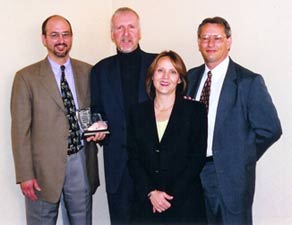
From
left-to-right: Robert Dennis, CFI; Director
James Cameron; Charlotte Huggins, NWAVE Pictures;
Paul Holliman, Buena Vista Film Dist.
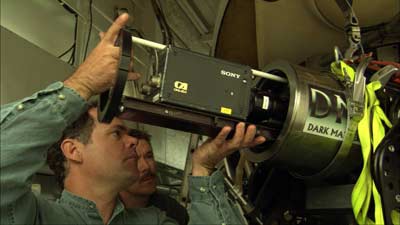
A crew member (left) prepares the unique camera as Mike Cameron (center) looks
on.
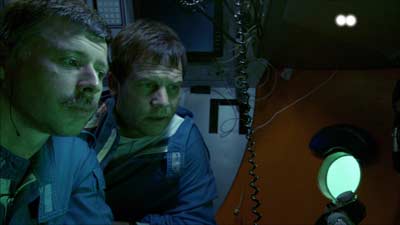
MIR 2 pilot Genya Chernaiev (left) and Bill Paxton (center) look through a
porthole in the submersible to the wreckage on the deck of Titanic.
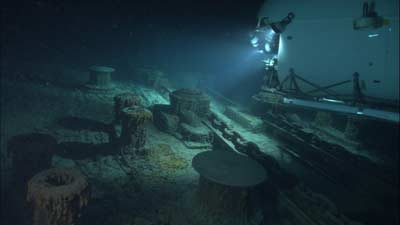
MIR at Titanic.
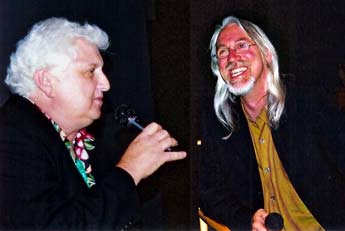
Writer Ray Zone and D.P. Rodney Taylor
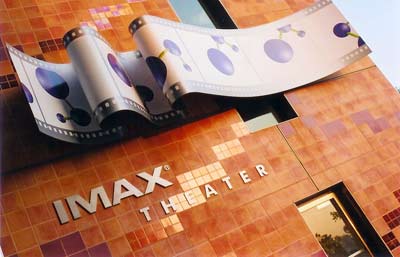
The California Science Center in Los Angeles
|